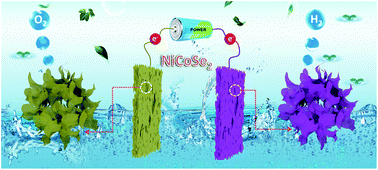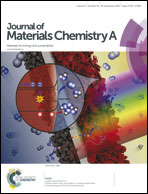Metallic and superhydrophilic nickel cobalt diselenide nanosheets electrodeposited on carbon cloth as a bifunctional electrocatalyst†
Abstract
Transition metal selenides have served as potential electrocatalysts due to their high electroconductivity, while their electrocatalytic performance is still far from being satisfactory. Herein, we report the construction of intrinsically metallic NiCoSe2 on carbon cloth with a crimped nanosheet configuration and highly open structure. This unique morphology endows NiCoSe2 with superhydrophilic properties, leading to close affinity with the electrolyte. Density functional theory (DFT) calculations indicate the combined contribution of Ni and Co elements to the electronic structure of the bimetallic selenides, revealing the strong interaction of the two metals toward enhanced electrical conductivity. Benefiting from the cooperative effects of the structural features, metallic nature and bimetal effect, NiCoSe2 exhibits superior electrocatalytic performance and robust durability toward overall water splitting, especially toward the oxygen evolution reaction (OER) with a low overpotential of 255.8 mV to deliver 10 mA cm−2 current density, indicating its enticing prospect in water electrolysis.



 Please wait while we load your content...
Please wait while we load your content...